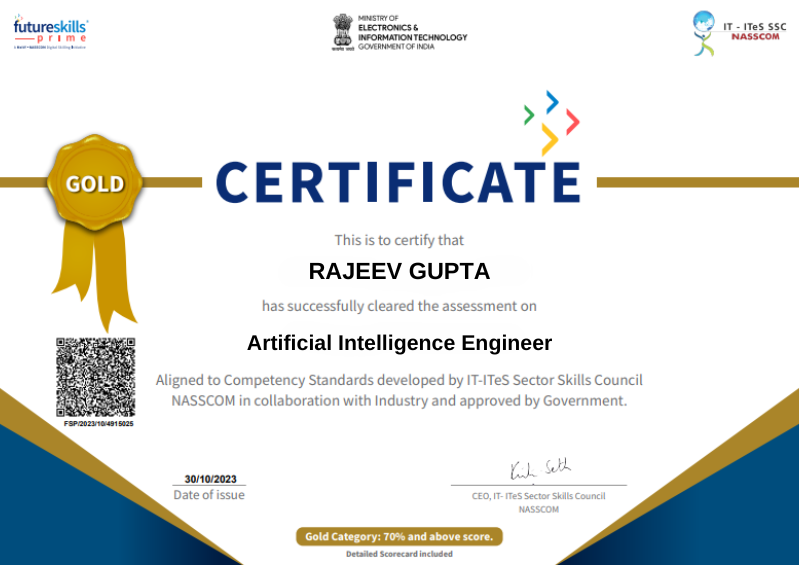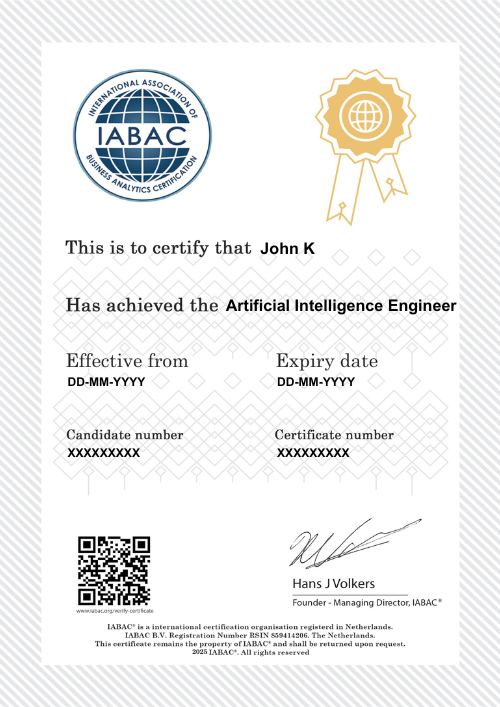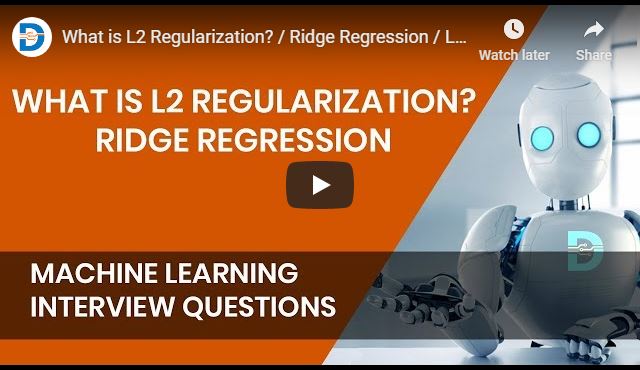Instructor Led Live Online
Self Learning + Live Mentoring
Customize Your Training


MODULE 1 : ARTIFICIAL INTELLIGENCE OVERVIEW
• Evolution Of Human Intelligence
• What Is Artificial Intelligence?
• History Of Artificial Intelligence
• Why Artificial Intelligence Now?
• Areas Of Artificial Intelligence
• AI Vs Data Science Vs Machine Learning
MODULE 2 : DEEP LEARNING INTRODUCTION
• Deep Neural Network
• Machine Learning vs Deep Learning
• Feature Learning in Deep Networks
• Applications of Deep Learning Networks
MODULE3 : TENSORFLOW FOUNDATION
• TensorFlow Structure and Modules
• Hands-On:ML modeling with TensorFlow
MODULE 4 : COMPUTER VISION INTRODUCTION
• Image Basics
• Convolution Neural Network (CNN)
• Image Classification with CNN
• Hands-On: Cat vs Dogs Classification with CNN Network
MODULE 5 : NATURAL LANGUAGE PROCESSING (NLP)
• NLP Introduction
• Bag of Words Models
• Word Embedding
• Hands-On:BERT Algorithm
MODULE 6 : AI ETHICAL ISSUES AND CONCERNS
• Issues And Concerns Around Ai
• Ai And Ethical Concerns
• Ai And Bias
• Ai:Ethics, Bias, And Trust
MODULE 1 : PYTHON BASICS
• Introduction of python
• Installation of Python and IDE
• Python Variables
• Python basic data types
• Number & Booleans, strings
• Arithmetic Operators
• Comparison Operators
• Assignment Operators
MODULE 2 : PYTHON CONTROL STATEMENTS
• IF Conditional statement
• IF-ELSE
• NESTED IF
• Python Loops basics
• WHILE Statement
• FOR statements
• BREAK and CONTINUE statements
MODULE 3 : PYTHON DATA STRUCTURES
• Basic data structure in python
• Basics of List
• List: Object, methods
• Tuple: Object, methods
• Sets: Object, methods
• Dictionary: Object, methods
MODULE 4 : PYTHON FUNCTIONS
• Functions basics
• Function Parameter passing
• Lambda functions
• Map, reduce, filter functions
MODULE 1 : OVERVIEW OF STATISTICS
• Introduction to Statistics
• Descriptive And Inferential Statistics
• Basic Terms Of Statistics
• Types Of Data
MODULE 2 : HARNESSING DATA
• Random Sampling
• Sampling With Replacement And Without Replacement
• Cochran's Minimum Sample Size
• Types of Sampling
• Simple Random Sampling
• Stratified Random Sampling
• Cluster Random Sampling
• Systematic Random Sampling
• Multi stage Sampling
• Sampling Error
• Methods Of Collecting Data
MODULE 3 : EXPLORATORY DATA ANALYSIS
• Exploratory Data Analysis Introduction
• Measures Of Central Tendencies: Mean,Median And Mode
• Measures Of Central Tendencies: Range, Variance And Standard Deviation
• Data Distribution Plot: Histogram
• Normal Distribution & Properties
• Z Value / Standard Value
• Empherical Rule and Outliers
• Central Limit Theorem
• Normality Testing
• Skewness & Kurtosis
• Measures Of Distance: Euclidean, Manhattan And Minkowski Distance
• Covariance & Correlation
MODULE 4 : HYPOTHESIS TESTING
• Hypothesis Testing Introduction
• P- Value, Critical Region
• Types of Hypothesis Testing
• Hypothesis Testing Errors : Type I And Type II
• Two Sample Independent T-test
• Two Sample Relation T-test
• One Way Anova Test
• Application of Hypothesis testing
MODULE 1: MACHINE LEARNING INTRODUCTION
• What Is ML? ML Vs AI
• Clustering, Classification And Regression
• Supervised Vs Unsupervised
MODULE 2: PYTHON NUMPY PACKAGE
• Introduction to Numpy Package
• Array as Data Structure
• Core Numpy functions
• Matrix Operations, Broadcasting in Arrays
MODULE 3: PYTHON PANDAS PACKAGE
• Introduction to Pandas package
• Series in Pandas
• Data Frame in Pandas
• File Reading in Pandas
• Data munging with Pandas
MODULE 4: VISUALIZATION WITH PYTHON - Matplotlib
• Visualization Packages (Matplotlib)
• Components Of A Plot, Sub-Plots
• Basic Plots: Line, Bar, Pie, Scatter
MODULE 5: PYTHON VISUALIZATION PACKAGE - SEABORN
• Seaborn: Basic Plot
• Advanced Python Data Visualizations
MODULE 6: ML ALGO: LINEAR REGRESSION
• Introduction to Linear Regression
• How it works: Regression and Best Fit Line
• Modeling and Evaluation in Python
MODULE 7: ML ALGO: LOGISTIC REGRESSION
• Introduction to Logistic Regression
• How it works: Classification & Sigmoid Curve
• Modeling and Evaluation in Python
MODULE 8: ML ALGO: K MEANS CLUSTERING
• Understanding Clustering (Unsupervised)
• K Means Algorithm
• How it works : K Means theory
• Modeling in Python
MODULE 9: ML ALGO: KNN
• Introduction to KNN
• How It Works: Nearest Neighbor Concept
• Modeling and Evaluation in Python
MODULE 1: FEATURE ENGINEERING
• Introduction to Feature Engineering
• Feature Engineering Techniques: Encoding, Scaling, Data Transformation
• Handling Missing values, handling outliers
• Creation of Pipeline
• Use case for feature engineering
MODULE 2: ML ALGO: SUPPORT VECTOR MACHINE (SVM)
• Introduction to SVM
• How It Works: SVM Concept, Kernel Trick
• Modeling and Evaluation of SVM in Python
MODULE 3: PRINCIPAL COMPONENT ANALYSIS (PCA)
• Building Blocks Of PCA
• How it works: Finding Principal Components
• Modeling PCA in Python
MODULE 4: ML ALGO: DECISION TREE
• Introduction to Decision Tree & Random Forest
• How it works
• Modeling and Evaluation in Python
MODULE 5: ENSEMBLE TECHNIQUES - BAGGING
• Introduction to Ensemble technique
• Bagging and How it works
• Modeling and Evaluation in Python
MODULE 6: ML ALGO: NAÏVE BAYES
• Introduction to Naive Bayes
• How it works: Bayes' Theorem
• Naive Bayes For Text Classification
• Modeling and Evaluation in Python
MODULE 7: GRADIENT BOOSTING, XGBOOST
• Introduction to Boosting and XGBoost
• How it works?
• Modeling and Evaluation of in Python
MODULE 1: TIME SERIES FORECASTING - ARIMA
• What is Time Series?
• Trend, Seasonality, cyclical and random
• Stationarity of Time Series
• Autoregressive Model (AR)
• Moving Average Model (MA)
• ARIMA Model
• Autocorrelation and AIC
• Time Series Analysis in Python
MODULE 2: SENTIMENT ANALYSIS
• Introduction to Sentiment Analysis
• NLTK Package
• Case study: Sentiment Analysis on Movie Reviews
MODULE 3: REGULAR EXPRESSIONS WITH PYTHON
• Regex Introduction
• Regex codes
• Text extraction with Python Regex
MODULE 4: ML MODEL DEPLOYMENT WITH FLASK
• Introduction to Flask
• URL and App routing
• Flask application – ML Model deployment
MODULE 5: ADVANCED DATA ANALYSIS WITH MS EXCEL
• MS Excel core Functions
• Advanced Functions (VLOOKUP, INDIRECT..)
• Linear Regression with EXCEL
• Data Table
• Goal Seek Analysis
• Pivot Table
• Solving Data Equation with EXCEL
MODULE 6: AWS CLOUD FOR DATA SCIENCE
• Introduction of cloud
• Difference between GCC, Azure,AWS
• AWS Service ( EC2 instance)
MODULE 7: AZURE FOR DATA SCIENCE
• Introduction to AZURE ML studio
• Data Pipeline
• ML modeling with Azure
MODULE 8: INTRODUCTION TO DEEP LEARNING
• Introduction to Artificial Neural Network, Architecture
• Artificial Neural Network in Python
• Introduction to Convolutional Neural Network, Architecture
• Convolutional Neural Network in Python
MODULE 1: GIT INTRODUCTION
• Purpose of Version Control
• Popular Version control tools
• Git Distribution Version Control
• Terminologies
• Git Workflow
• Git Architecture
MODULE 2: GIT REPOSITORY and GitHub
• Git Repo Introduction
• Create New Repo with Init command
• Git Essentials: Copy & User Setup
• Mastering Git and GitHub
MODULE 3: COMMITS, PULL, FETCH AND PUSH
• Code commits
• Pull, Fetch and conflicts resolution
• Pushing to Remote Repo
MODULE 4: TAGGING, BRANCHING AND MERGING
• Organize code with branches
• Checkout branch
• Merge branches
• Editing Commits
• Commit command Amend flag
• Git reset and revert
MODULE 5: GIT WITH GITHUB AND BITBUCKET
• Creating GitHub Account
• Local and Remote Repo
• Collaborating with other developers
MODULE 1: BIG DATA INTRODUCTION
MODULE 2: HDFS AND MAP REDUCE
MODULE 3: PYSPARK FOUNDATION
MODULE 4: SPARK SQL and HADOOP HIVE
MODULE 1: TABLEAU FUNDAMENTALS
• Introduction to Business Intelligence & Introduction to Tableau
• Interface Tour, Data visualization: Pie chart, Column chart, Bar chart.
• Bar chart, Tree Map, Line Chart
• Area chart, Combination Charts, Map
• Dashboards creation, Quick Filters
• Create Table Calculations
• Create Calculated Fields
• Create Custom Hierarchies
MODULE 2: POWER-BI BASICS
• Power BI Introduction
• Basics Visualizations
• Dashboard Creation
• Basic Data Cleaning
• Basic DAX FUNCTION
MODULE 3 : DATA TRANSFORMATION TECHNIQUES
• Exploring Query Editor
• Data Cleansing and Manipulation:
• Creating Our Initial Project File
• Connecting to Our Data Source
• Editing Rows
• Changing Data Types
• Replacing Values
MODULE 4 : CONNECTING TO VARIOUS DATA SOURCES
• Connecting to a CSV File
• Connecting to a Webpage
• Extracting Characters
• Splitting and Merging Columns
• Creating Conditional Columns
• Creating Columns from Examples
• Create Data Model
MODULE 1: NEURAL NETWORKS
• Structure of neural networks
• Neural network - core concepts(Weight initialization)
• Neural network - core concepts(Optimizer)
• Neural network - core concepts(Need of activation)
• Neural network - core concepts(MSE & RMSE)
• Feed forward algorithm
• Backpropagation
MODULE 2: IMPLEMENTING DEEP NEURAL NETWORKS
• Introduction to neural networks with tf2.X
• Simple deep learning model in Keras (tf2.X)
• Building neural network model in TF2.0 for MNIST dataset
MODULE 3: DEEP COMPUTER VISION - IMAGE RECOGNITION
• Convolutional neural networks (CNNs)
• CNNs with Keras-part1
• CNNs with Keras-part2
• Transfer learning in CNN
• Flowers dataset with tf2.X(part-1)
• Flowers dataset with tf2.X(part-2)
• Examining x-ray with CNN model
MODULE 4 : DEEP COMPUTER VISION - OBJECT DETECTION
• What is Object detection
• Methods of Object Detections
• Metrics of Object detection
• Bounding Box regression
• labelimg
• RCNN
• Fast RCNN
• Faster RCNN
• SSD
• YOLO Implementation
• Object detection using cv2
MODULE 5: RECURRENT NEURAL NETWORK
• RNN introduction
• Sequences with RNNs
• Long short-term memory networks(part 1)
• Long short-term memory networks(part 2)
• Bi-directional RNN and LSTM
• Examples of RNN applications
MODULE 6: NATURAL LANGUAGE PROCESSING (NLP)
• Introduction to Natural language processing
• Working with Text file
• Working with pdf file
• Introduction to regex
• Regex part 1
• Regex part 2
• Word Embedding
• RNN model creation
• Transformers and BERT
• Introduction to GPT (Generative Pre-trained Transformer)
• State of art NLP and projects
MODULE 7: PROMPT ENGINEERING
• Introduction to Prompt Engineering
• Understanding the Role of Prompts in AI Systems
• Design Principles for Effective Prompts
• Techniques for Generating and Optimizing Prompts
• Applications of Prompt Engineering in Natural Language Processing
MODULE 8: REINFORCEMENT LEARNING
• Markov decision process
• Fundamental equations in RL
• Model-based method
• Dynamic programming model free methods
MODULE 9: DEEP REINFORCEMENT LEARNING
• Architectures of deep Q learning
• Deep Q learning
• Reinforcement Learning Projects with OpenAI Gym
MODULE 10: Gen AI
• Gan introduction, Core Concepts, and Applications
• Core concepts of GAN
• GAN applications
• Building GAN model with TensorFlow 2.X
• Introduction to GPT (Generative Pre-trained Transformer)
• Building a Question answer bot with the models on Hugging Face
MODULE 11: Gen AI
• Introduction to Autoencoder
• Basic Structure and Components of Autoencoders
• Types of Autoencoders: Vanilla, Denoising, Variational, Sparse, and Convolutional Autoencoders
• Training Autoencoders: Loss Functions, Optimization Techniques
• Applications of Autoencoders: Dimensionality Reduction, Anomaly Detection, Image
The Artificial Engineer course offers the knowledge and skills that are required to become a successful AI Engineer. Precisely, the course talks about the ways to find a solution to complex problems, by employing deep learning, machine learning, computer vision, and NLP methods.
The Artificial Intelligence Engineer course helps to get a better understanding of Statistics for Data Science, Machine Learning, Deep Learning, Programming Such as Python and Tensor Flow.
Some of the prerequisites for pursuing the Artificial Engineer course are:-
Artificial Intelligence has gained importance across sectors and is instrumental in bringing change. Medical, Banking and Finance, Manufacturing, Retail, Hospitality, every sector of the economy uses AI. This can be attributed to the problem-solving capability in AI. Pursuing the Artificial Intelligence for Engineers course
DataMites is an authorized institute by the International Association of Business Analytics Certifications (IABAC™) providing global data science certification courses
Artificial intelligence (AI) refers to the use of computers and technology to mimic human intelligence and perform tasks that typically require human cognitive abilities, such as problem-solving and decision-making.
The term "artificial intelligence" was first introduced by John McCarthy, a renowned computer science professor at Stanford University.
Learning Artificial Intelligence offers numerous benefits as it is a rapidly growing field with vast potential. AI technologies like intelligent voice assistants, self-driving cars, and robotic process automation have gained significant prominence. The demand for AI professionals is high, and it opens doors to lucrative career opportunities.
Upon completing Artificial Intelligence Training, individuals can explore various job roles, including:
To excel in learning Artificial Intelligence, it is beneficial to have skills in computer programming, statistics, data modeling, data validation, and design. Non-technical skills such as critical thinking, curiosity, and a strong interest in math and science are also important.
A wide range of AI software development tools and platforms are accessible in the market, offering various capabilities for creating and implementing AI applications. Notable examples include Microsoft Azure AI Platform, Google Cloud AI Platform, IBM Watson, Infosys Nia, Dialog Flow, and BigML. These technologies furnish developers with frameworks and services that facilitate the development, deployment, and management of AI-powered solutions. By leveraging these advanced tools, developers can harness the potential of artificial intelligence to create innovative applications across diverse domains.
An AI Engineer is a professional who specializes in designing, developing, and implementing artificial intelligence systems and technologies to solve complex problems and create intelligent solutions.
The job responsibilities of an AI Engineer include designing and implementing AI models using deep learning neural networks and machine learning algorithms, collaborating with various stakeholders, conducting statistical analysis, automating processes, and translating machine learning models into usable APIs.
The key skills for AI Engineers include proficiency in mathematics, programming, analytics, business intelligence, communication, collaboration, and critical thinking.
According to Glassdoor.com:
The Artificial Intelligence Engineer Certification is important because it validates and demonstrates your expertise and skills in the field of artificial intelligence. It serves as a recognized credential that employers can trust, indicating that you have the necessary knowledge and proficiency to work on AI projects and contribute effectively to the industry. Having an AI Engineer Certification can enhance your career prospects, open up job opportunities, and increase your earning potential. It also showcases your commitment to continuous learning and professional development in the dynamic field of artificial intelligence.
The trainers for the Artificial Intelligence Engineer course have experienced Data Scientists, AI and Machine Learning experts who possess good knowledge of the subject matter.
No. Coding is not required to learn Artificial Intelligence Engineer courses.
You can enrol for the Artificial Intelligence Engineer Course by visiting our website, and doing the payment through Debit/Credit card, Visa. The receipt for the payment done will be sent to your registered E-mail id.
Yes. You will be given a certificate after the completion of the Artificial Intelligence Engineer course.
You will receive certification from IABAC® - International Association of Business Analytics Certification.
This course is perfectly aligned to the current industry requirements and gives exposure to all the latest techniques and tools. The course curriculum is designed by specialists in this field and monitored and improved by industry practitioners on a continual basis.
No, the exam fees are already included in the course fee and you will not be charged extra.
Course fee needs to be paid in one payment as it is required to block your seat for the entire course as well as book the certification exams with IABAC™. In case, if you have any specific constraints, your relation manager at DataMites™ shall assist you with part payment agreements
DataMites™ has a dedicated Placement Assistance Team(PAT), who work with candidates on an individual basis in assisting for the right Data Science job.
You get a 100% refund training fee if the training is not to your satisfaction but the exam fee will not be refunded as we pay to accreditation bodies. If the refund is due to your availability concerns, you may need to talk to the relationship manager and will be sorted out on case to case basis
DataMites™ provides loads of study materials, cheat sheets, data sets, videos so that you can learn and practice extensively. Along with study materials, you will get materials on job interviews, new letters with the latest information on Data Science as well as job updates.
To learn Artificial Intelligence effectively, it is advisable to enroll in DataMites' Artificial Intelligence Course, which provides comprehensive training to prepare you for future employment in the field.
DataMites offers the following Artificial Intelligence Certifications:
Prerequisites for an Artificial Intelligence Engineering course include basic knowledge of statistical tools and methodologies, programming skills in languages like Python, and a curious mindset.
The Artificial Intelligence Engineer course has a duration of 9 months, with training sessions available on weekdays and weekends.
The Artificial Intelligence Engineer program is suitable for graduates, newcomers interested in pursuing a career in AI, professionals in analytics looking to transition into AI roles, and team leaders or senior analysts seeking to enhance their skills.
By enrolling in online Artificial Intelligence Engineer training from DataMites, you can benefit from their accreditation by the International Association of Business Analytics Certification (IABAC), access to real-world projects and case studies, an IABAC certification upon completion, and the opportunity for an internship with Rubix, a global technology company.
The fee for the online Artificial Intelligence Engineer Training is as follows:
DataMites provides classroom training in Bangalore. However, arrangements for classroom training in other locations can be made on-demand, depending on the availability of other candidates from the same location.
Trainers at DataMites are certified and highly qualified professionals with extensive experience in the industry and expertise in the subject matter.
The Flexi-Pass offered by DataMites for the Artificial Intelligence Engineer training allows participants to attend sessions related to any queries or revision they may require for a duration of 3 months.
Upon completion of the training, participants will receive an IABAC certification, which is globally recognized for relevant skills.
Yes, after completing the course, DataMites will issue a Course Completion Certificate.
In case you miss a session, you can contact your instructors to schedule a makeup class. For online training, all sessions are recorded and uploaded for participants to catch up at their own pace.
Yes, DataMites provides a free demo class to give participants a brief idea of the training methodology and what to expect from the course.
Yes, DataMites has a dedicated Placement Assistance Team (PAT) that provides placement facilities to participants upon completion of the course.
The DataMites Placement Assistance Team (PAT) offers services such as job connections, resume creation, mock interviews with industry professionals, and interview question discussions to help participants kickstart their careers in Artificial Intelligence.
The career mentoring sessions conducted by the Placement Assistance Team (PAT) aim to guide participants in understanding the various career options available in Artificial Intelligence, the challenges they may face as newcomers, and strategies to overcome them. Industry experts provide insights and help participants explore their career paths.
Yes, participants are encouraged to make the most of their training sessions and can request additional support sessions for further clarification.
DataMites accepts payments through various methods, including cash, net banking, checks, debit cards, credit cards, PayPal, Visa, Mastercard, and American Express.
The DataMites Placement Assistance Team(PAT) facilitates the aspirants in taking all the necessary steps in starting their career in Data Science. Some of the services provided by PAT are: -
The DataMites Placement Assistance Team(PAT) conducts sessions on career mentoring for the aspirants with a view of helping them realize the purpose they have to serve when they step into the corporate world. The students are guided by industry experts about the various possibilities in the Data Science career, this will help the aspirants to draw a clear picture of the career options available. Also, they will be made knowledgeable about the various obstacles they are likely to face as a fresher in the field, and how they can tackle.
No, PAT does not promise a job, but it helps the aspirants to build the required potential needed in landing a career. The aspirants can capitalize on the acquired skills, in the long run, to a successful career in Data Science.











